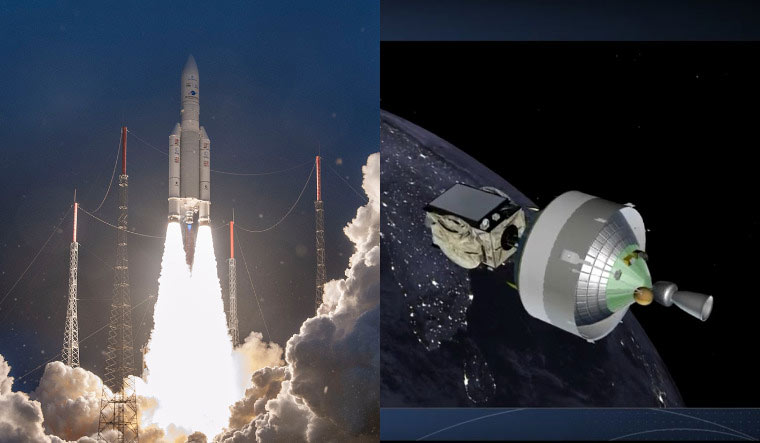India's "high power" communication satellite GSAT-30, aimed at providing high-quality television, telecommunications and broadcasting services, was successfully launched on board the Ariane 5 rocket from French Guiana in the early hours of Friday, the Indian Space Research Organisation (ISRO) said.
Blasting off from the Ariane Launch Complex in Kourou, a French territory located on the northeastern coast of South America at 2:35am IST, Arianespace's Ariane 5 vehicle injected GSAT-30 into orbit in a flawless flight lasting about 38 minutes. Arianespace is a European space consortium.
"#GSAT30 successfully separated from the upper stage of #Ariane5 #VA251" ISRO said in a tweet.
Confirming the successful launch, Arianespace CEO Stphane Isral tweeted, "A strong start to 2020 as #Ariane5 successfully deploys its two satellite passengers EUTELSAT KONNECT and GSAT-30 into geostationary transfer orbit! I appreciate the trust from the two customers on this mission: @Eutelsat_SA and @ISRO #VA251 #MissiontoSuccess."
ISRO's U R Rao Satellite Centre Director P. Kunhikrishnan, who was present in Kourou, congratulated the ISRO community and Arianespace team on the successful launch.
Calling it an "excellent start" to 2020 for ISRO with the launch, he said, "The mission team at the master control facility have already acquired the satellite and they will immediately complete the post launch operations..."
The 3,357-kg satellite, which was deployed from the lower passenger position of Ariane-5 launch vehicle (VA 251) into geostationary transfer orbit (GTO), is configured on ISRO's enhanced I-3K Bus structure to provide communication services from geostationary orbit in C and Ku bands.
The satellite derives its heritage from ISRO's earlier INSAT/GSAT satellite series, and is equipped with 12 C and 12 Ku band transponders.
GSAT-30 is to serve as replacement to the "ageing" INSAT-4A spacecraft services with enhanced coverage, ISRO has said, adding the satellite provides the Indian mainland and islands coverage in Ku-band and extended coverage in C-band covering Gulf countries, a large number of Asian countries and Australia.
With a mission life of 15 years, GSAT-30 is an operational communication satellite for DTH, television uplink and Very Small Aperture Terminal (VSAT) services.
ISRO has said the communication payload of GSAT-30 is specifically designed and optimised to maximise the number of transponders on the spacecraft bus.
also read
- Why is specialised coating essential for the delayed NISAR mission’s antenna?
- 'Pushpak': All you need to know about ISRO's RLV and its successful landing
- Why ISRO has pinpointed 48 locations for safe return of Gaganyaan astronauts
- S. Somnath says his family was 'shocked' after cancer diagnosis on Aditya-L1 launch day
- Explained: How Gaganyaan astronauts will benefit from simulator training
According to the space agency, the spacecraft would be extensively used for supporting VSAT network, television uplinking and teleport services, digital satellite news gathering (DSNG), DTH television services, cellular back-haul connectivity and many such applications.
One Ku-band beacon downlink signal is transmitted for ground-tracking purpose, it added.
EUTELSAT KONNECT, which was produced by Thales Alenia Space for Eutelsat, was riding in the upper position of Ariane 5's payload arrangement, and was released first in the flight sequence at 27 minutes following lift-off.
Since the launch of India's APPLE experimental satellite on Ariane Flight L03 in 1981, Arianespace has orbited 24 satellites, including GSAT-30, for the ISRO.



